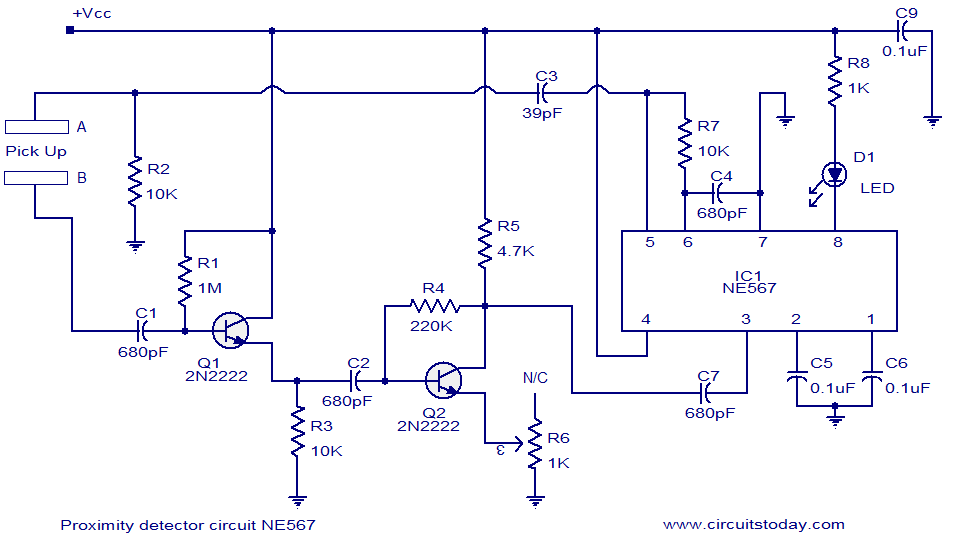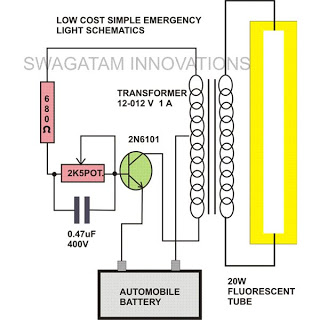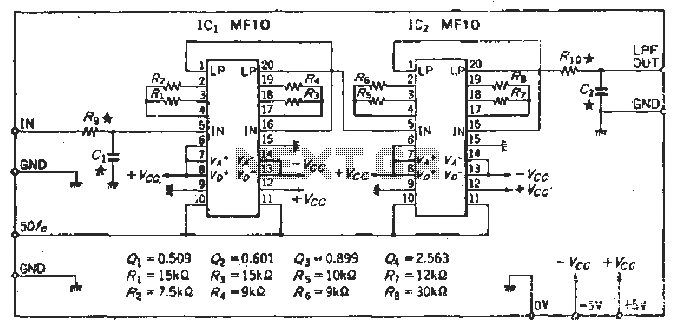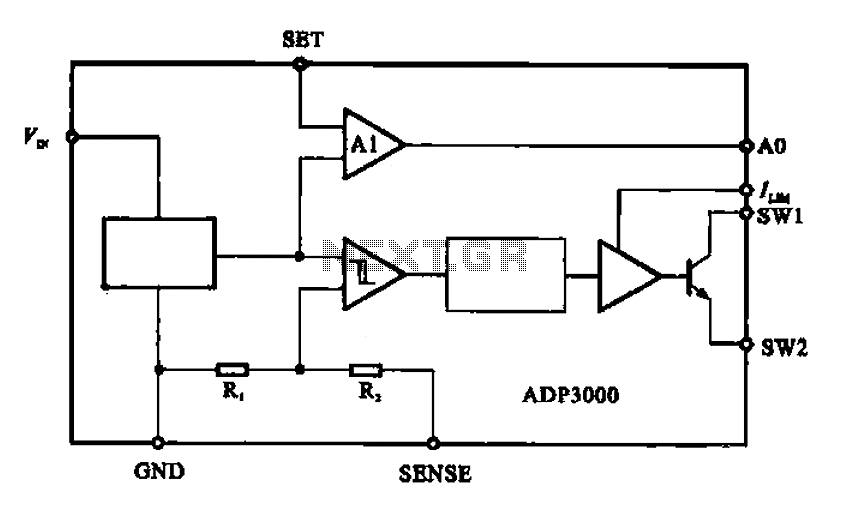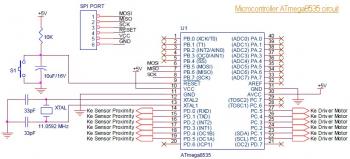
led music level indicator light circuit
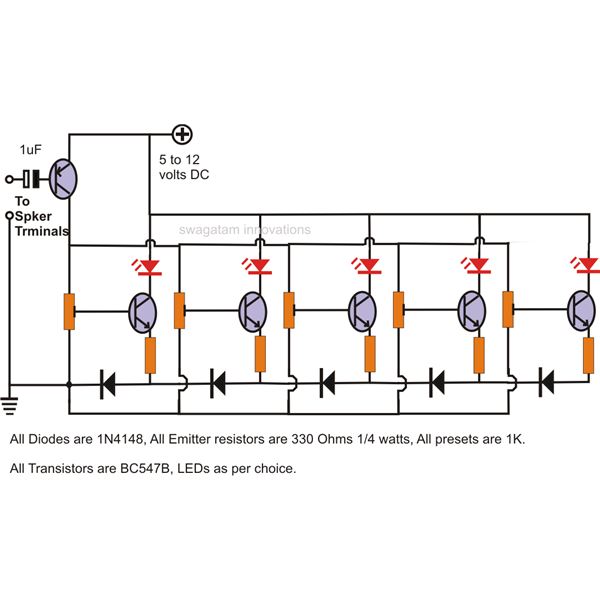
The LEDs in the circuit light up sequentially and "dance" in response to the music level applied at the input, preferably from the speaker terminals of the audio device being monitored. This configuration is consistent across all LEDs in the circuit, achieving a desired push-pull effect in relation to the music level. Upon closer examination of the circuit, it is evident that the ground connection to the first transistor/LED stage on the left passes through a single diode, whereas the ground potential of the preceding stages must pass through an increased number of diodes. Each diode has a forward voltage drop of approximately 0.6 volts, which results in the first transistor conducting sooner than the second, the second sooner than the third, and so forth. As the number of diodes in the path of each respective transistor increases, the conduction is delayed until the voltage surpasses the cumulative forward voltage drop of the diodes. This voltage increase occurs only when the pitch of the music rises, creating a sequential LED bar graph that illuminates in response to the pitch or loudness of the input music. The input transistor is a PNP type, complementing the other transistors used to illuminate the LEDs. The PNP transistor amplifies the low-level music signal to a level sufficient for activating the LEDs based on the music levels.
In this circuit, the sequential LED display serves as a visual representation of audio input levels, effectively transforming sound energy into light energy. The PNP transistor at the input stage plays a crucial role by amplifying the low-level audio signal extracted from the speaker terminals. This amplification is essential, as it ensures that even subtle variations in music volume can be detected and represented visually by the LEDs.
The arrangement of diodes in the circuit introduces a series voltage drop that affects the conduction threshold of each subsequent transistor. By limiting the current flow through each transistor with the diodes, the circuit creates a cascading effect where each LED lights up in response to increasing audio levels. This behavior mimics the dynamic nature of music, where changes in pitch and loudness are represented by the sequential illumination of the LEDs.
The design is particularly effective for visualizing audio signals, as it allows for immediate feedback in response to changes in the music. As the audio input varies, the circuit responds by illuminating the LEDs in a manner that reflects the intensity and frequency of the sound, thus creating an engaging visual display. The overall configuration not only enhances the aesthetic appeal of audio devices but also provides users with an intuitive understanding of audio levels through visual feedback.The shown LEDs in the circuit sequentially light and "dance" as per the level of the music applied at the input, preferable directly from the speaker terminals of the audio gadgetwhosemusic level is to be monitored. The above stage is identical to all the LEDs included in the circuit for obtaining the desired push-pull effect in response to th
e applied music level at the input. If you see the circuit closely you will find that the the ground to the first transistor/LED stage from left comes across only a single diode, however the preceding stages ground potential has to encounter the extracorrespondingnumber of diodes in theor path. As we allknowthat a diode has thepropertyof dropping 0. 6 volts, means that the first transistor would conduct much sooner than the second, the second transistor conducts sooner than the third and so on.
Because as the number of diodes increase in the path of therespectivetransistor, the conduction is inhibited until the the voltage sufficiently increases for bypassing the diodes overall forward voltage. This increase in voltage can happen only when the pitch of the music increases, giving rise to a sequentially running LED bar graph which shoots forward in response to the pitch or loudness o the applied input music.
The transistor at the inputisa PNP and complements the rest of the transistors employed forilluminatingthe LEDs. The PNP transistor at the input amplifies the applied low level music sinal to levels which is just enough for illuminating the LEDs with reference to themusiclevels, .
🔗 External reference
In this circuit, the sequential LED display serves as a visual representation of audio input levels, effectively transforming sound energy into light energy. The PNP transistor at the input stage plays a crucial role by amplifying the low-level audio signal extracted from the speaker terminals. This amplification is essential, as it ensures that even subtle variations in music volume can be detected and represented visually by the LEDs.
The arrangement of diodes in the circuit introduces a series voltage drop that affects the conduction threshold of each subsequent transistor. By limiting the current flow through each transistor with the diodes, the circuit creates a cascading effect where each LED lights up in response to increasing audio levels. This behavior mimics the dynamic nature of music, where changes in pitch and loudness are represented by the sequential illumination of the LEDs.
The design is particularly effective for visualizing audio signals, as it allows for immediate feedback in response to changes in the music. As the audio input varies, the circuit responds by illuminating the LEDs in a manner that reflects the intensity and frequency of the sound, thus creating an engaging visual display. The overall configuration not only enhances the aesthetic appeal of audio devices but also provides users with an intuitive understanding of audio levels through visual feedback.The shown LEDs in the circuit sequentially light and "dance" as per the level of the music applied at the input, preferable directly from the speaker terminals of the audio gadgetwhosemusic level is to be monitored. The above stage is identical to all the LEDs included in the circuit for obtaining the desired push-pull effect in response to th
e applied music level at the input. If you see the circuit closely you will find that the the ground to the first transistor/LED stage from left comes across only a single diode, however the preceding stages ground potential has to encounter the extracorrespondingnumber of diodes in theor path. As we allknowthat a diode has thepropertyof dropping 0. 6 volts, means that the first transistor would conduct much sooner than the second, the second transistor conducts sooner than the third and so on.
Because as the number of diodes increase in the path of therespectivetransistor, the conduction is inhibited until the the voltage sufficiently increases for bypassing the diodes overall forward voltage. This increase in voltage can happen only when the pitch of the music increases, giving rise to a sequentially running LED bar graph which shoots forward in response to the pitch or loudness o the applied input music.
The transistor at the inputisa PNP and complements the rest of the transistors employed forilluminatingthe LEDs. The PNP transistor at the input amplifies the applied low level music sinal to levels which is just enough for illuminating the LEDs with reference to themusiclevels, .
🔗 External reference
